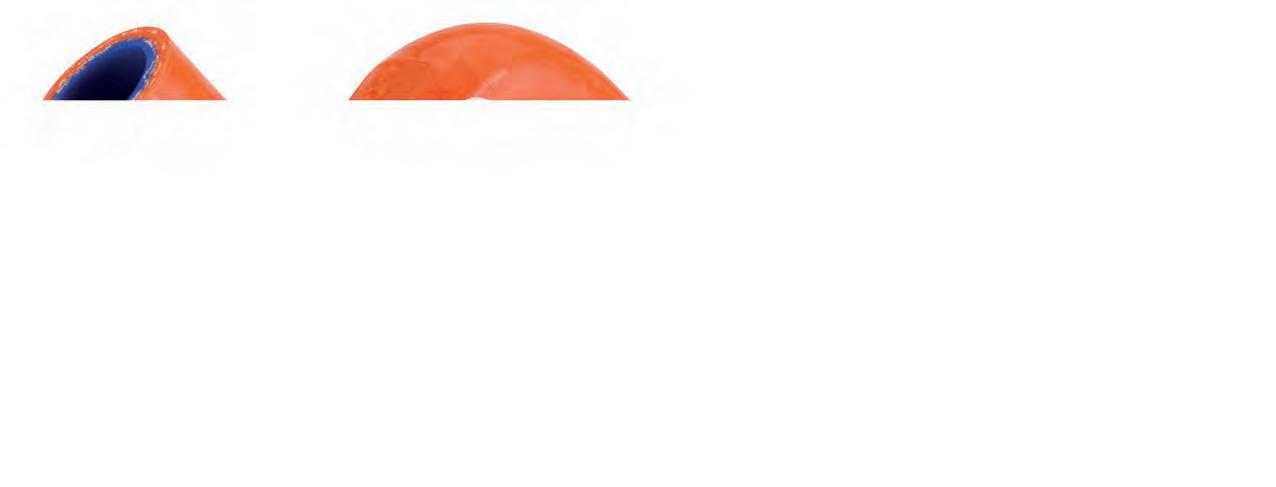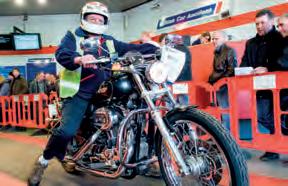
13 minute read
International news – Asia to the rescue
International news International news
With financial editor Roger Willis
Asia to the rescue



The trio of Japanese bike manufacturers still bean-counting on the basis of traditional fiscal years beginning in April also share three common denominators. Reporting firstquarter results to the end of June, they have clearly all benefited by focusing on resurgent high-volume Asian markets. Their North American sales recovery has been a welcome surprise. And they are maintaining or even extending optimistic annual forecasts
HONDA: EMERGING PROFITS
Blasting off the line with vigour, Honda produced an excellent first-quarter performance. However, the small print pointed to Asia and other emerging markets as largely responsible for this success.
Honda’s global motorcycle business revenue put on an impressive 30.5% to £4.18bn. Associated operating profit grew by 21.3% to £605m – but operating margin fell to 14.5% from 15.6%. Total sales volume during the period was 9.6% up to 4.251 million powered twowheelers.
Asian sales led the charge, rising by 10.5% to 3.585 million. And at the heart of this advance was an extraordinary bounceback in India, the world’s largest PTW market. Sales by Honda’s wholly-owned Indian subsidiary HMSI more than doubled, 102.6% up to 995,000.
Some big countries in Asia were impacted harder by ongoing semiconductor supply shortages, though. Shipments from Indonesian joint-venture affiliate Astra Honda dropped by 22.1% to 684,000, Vietnam was 9.9% down to 532,000 and Thailand lost a more marginal 0.7% at 334,000.
The headcount across other
emerging regions, with Latin America to the fore, rose by 14.5% to 419,000. Sales based on bikes from Honda’s Manaus manufacturing hub in Brazil increased by 9.4% to 275,000.
Developed-world figures were less satisfactory. European sales declined by 25% to 81,000. Honda’s Japanese domestic sales shrank by 5.1% to 56,000. But North America added 8.9% to 110,000.
However, Honda is maintaining forecasts despite the microchip famine, and says it will strive to exceed them by utilising alternative parts and deleting certain models.
Currently, for the full year to March 2023, total sales volume is predicted to grow by 9% to 18.56 million. Asia should be 9.2% higher at 15.93 million and other emerging markets 9% better off on 1.57 million. Europe is projected to finish 12%
up to 355,000. North America will more-or-less hold station on 440,000. Japan is set to put on 8.6% to 265,000.
In sharp contrast to all this qualified optimism, Honda’s Q1 car business results were even more dire than usual. Although its monumental automotive turnover rose by 3.4% to £14.417bn, associated operating profit plunged – 45.9% down to a mere £237m. Operating margin deteriorated from an already very poor 3.1% to just 1.6%.
Yen-sterling currency translation at forex rates applicable on 10 August

KAWASAKI: MIXED MESSAGES
Just like its Japanese “big four” compatriots, the motorcycle division of Kawasaki Heavy Industries is banking on boosts from almost every major global market except Europe for postpandemic prosperity. But it struggled with rising raw material costs and worldwide logistics problems, affecting profitability in the first quarter, and is now responding with higher prices.
Overall divisional revenue in Q1 grew by 11.1% to £783m. But turnover from wholesale motorcycle shipments into developed countries was 1.1% down to £287m and associated volume fell by 10.9% to 49,000 bikes. Within that, North America (the USA and Canada) was 18.2% up to 26,000, while European shipments plummeted by 47.6% to just 11,000. Kawasaki’s domestic Japanese market increased by 33.3% to 8000. Australia shrank by a similar percentage to 2000.
Conversely, revenue from emerging motorcycle markets, predominantly in South-East Asia, rose by 16.4% to £158m. Volume put on 18% to 72,000 bikes. The Philippines and Indonesia were biggest recipients, together achieving a 35.7% increase to 57,000.
Global sales of utility vehicles, quadbikes and personal watercraft were 20.8% up to £195m and general-purpose petrol engines added 21.3% to £143m.
However, despite help from a depreciating yen exchange rate, manufacturing input price inflation and supply-chain issues resulted in a 13.6% Q1 operating profit decline to £80m. Operating margin sank from 13.1% in the same period last year to 10.2%.
On a brighter note, Kawasaki says demand remains strong in key markets and it is confident of being able to meet targets with enhanced supply at reduced costs in subsequent quarters. Annual forecasts have therefore been revised upwards. 12-monthly projected revenue for the division has been raised from £3.106bn to £3.229bn. Operating profit should now reach £279m, instead of £266m.
Yen-sterling currency translation at forex rates applicable on 15 August
SUZUKI: NEW ASPIRATION
Suzuki Motor Corporation’s motorcycle business blossomed in Q1. Again, a resurgence in Asian sales was largely responsible. Total revenue soared by 50.1% to £534.5m. Operating profit stacked on 87.4% at £51.5m. Global sales volume rose by 30.4% to 472,000 motorcycles, scooters and ATVs. Asia accounted for 383,000 of them, a 36.3% increase. Associated revenue from Asian countries improved by 53.5% to £242.3m. Most notable contributor was India, where volume recovered by 75.8% to 167,000. China added 5.4% to 120,000. The Philippines and Pakistan also received honourable mentions, respectively 27.3% up to 48,000 and 34.9% higher to 10,000. Developed-world markets were less attractive. The exception was North America, where revenue more than doubled to £92.1m and sales volume grew by 11.7% to 11,000. European turnover did improve significantly, 29.6% up to £70.5m. But volume fell by 9.3% to just 9000. Better large model mix featuring the new GSXS1000GT and ongoing Hayabusa revival was flagged as useful in both cases. Japanese domestic performance was lamentable. Sales volume declined by 19.5% to 13,000 and revenue virtually flatlined, a mere 1% up to £37.9m. Suzuki’s full-year forecast remains unchanged. The motorcycle business plans to make 1.721 million machines, a 3.5% reduction, and sell 1.787 million, a 9% increase. Asian sales are expected to rise by 10.5% to 1.463 million. Most ambitiously, it anticipates a 34.6% increase in European sales to 38,000. A rather obtuse reference to introducing Indian-manufactured models to Europe may have some bearing on this aspiration. Yen-sterling currency translation at forex rates applicable on 5 August www.britishdealernews.co.uk


DYNAMIC
DYNAMIC COMMUNICATION MESH MESH
COMMUNICATION

International news
When the going gets tough…


In a currently stressful worldwide economic climate, some leading motorcycle manufacturers reporting results that span the first half of 2022 did much better than others. But they are all aware of unpredictable challenges ahead. BDN financial editor Roger Willis surveys a mixture of optimism and pessimism
BMW: BOXER KNOCKABOUT
Business got steadily more difficult for BMW Motorrad. And the company doesn’t expect a recovery any time soon. Revenue for the full six months was a slim 2.6% up to £1.393bn. But operating profit declined by 17.3% to £197m and operating margin fell from 17.5% to 14.1%. Net profit was 12.6% down.
Global half-yearly retail sales volume dropped marginally by 0.1% to 107,555 motorcycles and maxiscooters. April-June numbers, when the seasonal shift should have indicated a strengthening performance, turned more consistently negative instead. Q2 retail bike deliveries to customers worldwide had retreated by 7.5% to 60,152. BMW Motorrad assiduously avoids providing sales data for individual markets in its quarterly statements. However, from MCIA sources we know UK headcount in Q2 was much worse – 31.4% down to 2172.
As for the money, Q2 revenue fell by 0.5% to £723m. Operating profit sank by 14.8% to £106m and net profit was 12.5% in arrears at £88m.
BMW Group fielded plenty of valid excuses in the results statement, admitting that it had assumed the supply situation for semiconductor components would ease during the second half of 2022. However, availability is now no longer expected to improve appreciably over the remainder of the year, engendering an impact on production and sales.
The group also anticipates higher raw materials and energy costs in the second half, the latter due to reduced gas supplies, cranking up output prices. And it says rising inflation and interest rates worldwide are likely to influence consumer spending behaviour in the coming months.
A significant slowdown in global economic activity and reduced IMF growth projections also get mentions, with the corporate finger pointing straight at the war in Ukraine and intensification of supply-chain problems.
Euro-sterling currency translation at forex rates applicable on 3 August
DUCATI: GLASS HALF FULL
A challenging environment, due to semiconductor and other component shortages plus rising raw materials costs, led to reduced production and sales at Ducati. But premium pricing successfully propped up turnover and profit.
Revenue in the period grew by 5.4% to £455m, an all-time record. Operating profit was 15.3% up to £57m, with an operating margin increase to 12.6% from 11.5%. However, half-yearly production was 3.1% down to 35,835 motorcycles. Retail sales fell by 3.6% to 33,265 across the full six months and had worsened, moving into peak-season Q2, on an 8.8% decline to 19,798.
Diavel, Monster and Streetfighter models in the naked segment topped the overall pile, 4.8% higher to 11,115 bikes sold. But dualsport, spanning DesertX, Hypermotard and Multistrada products, was assuredly more lucrative. Sales volume rose by 5% to 10,709. Some 8301 of these were Multistrada V4 outright best-sellers for the brand. But Ducati’s Scrambler sub-brand took a spanking, 28.4% down to 4989. Sports tackle, comprising Supersport and Panigale machines, also sank into negativity, 4.3% lower at 6452.
SCAN FOR
DEALER PACK THE BENCHMARK



FOR PERFORMANCE SILICONE HOSE

Globally, Europe accounted for 57% of all Ducati sales, growing from 55% in the first half of last year. Italy claimed the biggest volumetric slice of that on 6028 bikes. Germany followed with 3745 and the French bought 2647. North America shifted 12%, declining from 14%, and worth 5239 bikes exiting showroom doors. China rose from 6% to 7%, equating to 2411. The remaining 24% was unattributed.
Euro-sterling currency translation at forex rates applicable on 29 July
HARLEY-DAVIDSON: AGAINST ALL ODDS
Beating gloomy Wall Street analysts’ estimates for the six months of 2022 to date and Q2 in particular, Harley-Davidson’s results were welcomed by investors – pushing its share price almost 8% higher on their release date.
The company got away with increasing prices in the face of strong domestic demand, even though it was struggling to satisfy orders due to supply-chain woes. And, significantly, Harley supremo Jochen Zeitz stood by his upbeat full-year forecast.
Nevertheless, total six-monthly revenue virtually flatlined, rising by just 0.3% to £2.443bn. The contribution from motorcycles and related products was pretty static too, a mere 0.2% up to £2.116bn. Both turnover and operating profit from that direction, the latter falling by 4.5%, had been adversely impacted by a two-week production halt during May, that slashed wholesale bike shipments by 15% in Q2. The disruption had been caused by regulatory compliance issues at a component supplier.
Profits from the HDFS consumer credit and dealer inventory funding arm also declined, 19.2% down to £141.8m. This was attributed to an increased allowance for lending default losses. Overall operating profit was 9.5% lower at £467.1m and net profit fell by 5.8% to £361.2m.
Shipments to dealers worldwide over the six months in question were 7.6% down to 103,011 bikes. Within that, US domestic share sank by a harsher 15.7% to 64,276. Hardest-hit model segment was Touring, where showrooms received 16.9% fewer machines, amounting to 47,770. Cruiser were nearly as bad, 14.4% down to 30,450. Conversely, Harley plants in Wisconsin and Pennsylvania shipped 13% more Sportster and Street models, adding up to 16,212. Adventure, filled by the groundbreaking Pan America 1250, made the most significant advance by more than doubling its numbers – up 111.9% to 8579.
Global retail sales dropped by 12.7% to 95,604. US domestic numbers shrank by 19.1% to 61,228. Canada copped a more minor retreat of 5.4% to 4962 bikes ridden away from dealers. The EMEA region, dominated by Europe, fell by a marginal 1% to 15,041 – despite having been boosted by sharply reduced EU and UK import tariffs. On a brighter note, Asia-Pacific countries grew by 8.4% to 12,773 and Latin America added 1.8% to 1600.
Ebullient as ever, Harley-Davidson chairman, chief executive and president Zeitz commented: “Reaffirming our guidance for the year, despite the production suspension, demonstrates the effectiveness of our strategy and the power of our brand. With the suspension behind us, we are fully focused on mitigating impacts of the volume loss with the ambition to deliver on our goals.”
Dollar-sterling currency translation at forex rates applicable on 28 July
PIAGGIO: SOLID PROGRESS
Despite its chairman and chief executive Roberto Colaninno complaining about “the current difficulties in procuring electronic components”, Piaggio Group posted firm turnover, bike sales volume and profitability advances.
Overall revenue grew by 16.8% to an all-time record of £882.6m. Within that, income from powered two-wheelers plus associated spares and accessories was 15.1% up to £733.8m. Total operating profit was 6.7% higher at £71.9m. But operating margin dropped from 8.8% to 8.1%. Net profit rose by 3.9% to £37.9m – Piaggio’s best first-half performance since 2008. Net debt was reduced by 1.1% to £333.1m, versus the position 12months earlier.
Global sales volume prospered by 11.8% to 271,600 scooters and motorcycles. Asia-Pacific markets put on 27%. North and South America were 26.3% up. The EMEA grouping, primarily Europe, added 7%. However, volume in India suffered a 7.4% decline – although associated revenue improved by 11.2%.
Piaggio claimed ongoing European scooter market leadership with a 22.5% share and 31% of North American scooter sales. It said the Vespa brand was principal driver of doubledigit percentage scooter growth globally. Good performances were noted in Indonesia, Vietnam, China, India, the Americas and Italy.
Turning vague about motorcycles as usual, because numbers are relatively small, the company asserted volume growth of “around 30%”. Moto Guzzi had “a very strong first half” thanks to V7 and V85TT retro models. Aprilia was also “extremely positive”, led by new Tuareg and established RS 660cc products.
Euro-sterling currency translation at forex rates applicable on 1 August
YAMAHA: GOOD, BAD AND UGLY
Yamaha’s motorcycle business held up remarkably well. But an erratic model mix meant increased turnover was sullied by reduced profitability.
Total revenue climbed by 16.7% to £3.716bn. However, global wholesale volume flatlined, 0.3% down to 2.306 million bikes. And patchy numbers, especially in developed-world markets where higher-yield model mix and cost of sales are crucial, resulted in an operating profit decline of 2.2% to £221.3m.
European unit sales fell by 6.9% to 108,000 machines. North America did better, rising by 5.9% to 36,000. The Japanese domestic market was 5.9% down to 48,000. Asia retreated marginally by 1% to 1.826 million, against muscular revenue growth of 14.4% to £2.206bn. Various other markets taken together – including Latin America, Australia and New Zealand – added 8.7% to 288,000.
Yamaha’s Land Mobility division, for which motorcycles are the key gravy train, had a more torrid time. While divisional revenue was 15.6% up at £4.219bn, operating profit sank by 18.1% to £224.9m – all bar £3.6m coming from bikes. The culprit was its loss-making recreational offroad vehicle business. More proof of the “two wheels good, four wheels bad” axiom?
For parent Yamaha Motor as a whole, halfyearly revenue was 16.2% up to £6.55bn and operating profit 6.2% down to £627.7m. Biggest single contributor at operating level was the Marine Products division, stacking on 12.6% to £304.7m with less than half of Land Mobility’s turnover. Net profit dropped by 10.8% to £508.5m.
Yen-sterling currency translation at forex rates applicable on 10 August










